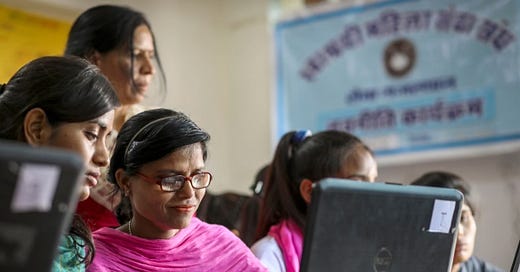Can AI solve the gender financial literacy gap?
With the right tools in place, AI could be the solution for supporting women in becoming more financially literate and autonomous.
Photo Credit: SEWA Bharat
Written by: Jillian Hayden
One billion women around the world still don't have access to financial services, despite women's growing share of global consumer spending. Women continue to trail behind men in terms of obtaining access to banking, financial literacy, and trustworthy institutions. Globally, women earn 63 per cent less than men, yet they spend three times as many hours on unpaid labour, such as childcare and housework. Additionally, four in 10 women do not have a financial account of any kind.
As our current gender literacy gap is not closing at its expected rate, can artificial intelligence (AI) be the answer to deliver accessible and free financial literacy to women around the world?
It's possible that women are unaware of the resources at their disposal or are discouraged from using them. They might not have the money or means to travel to banking institutions, or they might live too far away to do so. It's also possible that certain women are prevented by men in their family from travelling alone.
Frequently, women experience banks as second class citizens. More often than not, women don't have the collateral needed for loans due to cultural estate practices where men disproportionately inherit assets, making it difficult to launch a business. When combined, these limitations create an unsustainable mix that leads to economic marginalization.
In Gujarat, India, proximity to financial institutions and educational resources create a gap in accessibility for many female agriculture workers. Despite having the agency to open an account, they would have to leave their crops, children and household tasks to travel for financial literacy training. This is a substantial barrier.
The Self Employed Women's Association (SEWA) saw this issue and increased the amount of online training sessions that were offered so that more entrepreneurs could join. While working as a livelihood fund monitor at SEWA in 2021, I noticed participants had difficulty getting post-training follow-up support, such as help with recalculating interest rates after missed payments or creating personalized budgets. Those located in urban areas, with closer proximity to financial resources and support, were often more successful in paying off their loans.
The persistent gender gap in financial literacy demands innovative solutions, and AI presents a powerful toolkit for supporting those with limited financial literacy. AI platforms can personalize learning by analyzing individual financial situations and goals, providing tailored advice and educational resources on the concepts most relevant to specific needs within seconds. This can help individuals understand basic money management skills and put them into practice with AI acting as a 24/7 financial coach. AI can also make financial education more engaging and accessible. Gamified platforms turn learning into an interactive experience, while simulations allow for risk-free practice of real life financial scenarios.
Additionally, AI's data analysis can go beyond individual users. By identifying trends and patterns related to the gender gap, AI can inform the development of targeted programs and policies that address the specific challenges women face in achieving financial literacy. For example, many women are unaware of their financial rights and their agency over their own money, and will give control to male figures in their lives. AI can integrate a rights-based approach into its financial literacy support, emphasizing individual’s autonomy over their finances. While AI holds immense promise for financial literacy, it's important to acknowledge its limitations and potential pitfalls. One concern is bias in the data used to train AI models. If historical data perpetuates existing gender biases, the AI recommendations might only reinforce those inequities.
Fundamentally, the effectiveness of AI powered learning hinges on user engagement. If the platforms aren't user friendly or fail to cater to diverse learning styles, they risk excluding the very demographics they aim to empower. Furthermore, the expanded role for AI shouldn’t replace human financial advisors entirely. Complex financial decisions might still benefit from the judgment and emotional intelligence that a human advisor can provide.
Overall, AI should be seen as a valuable tool to complement financial education, not a complete replacement for human expertise.
It is also important to note that although technology has become widespread throughout the world, there are still many emerging economies with low access to the internet and technology where they can access AI. To illustrate, with only approximately 41 per cent of the population in Haiti having access to the internet, the majority are prevented from accessing financial services, especially in rural areas.
Adults registered with bank accounts live mostly in urban areas where internet connection is easier to find, with 36.8% of residents in Haiti’s capital, Port-au-Prince, being registered, compared to only 12.1% for rural non-connected areas. Income also plays a clear role, with those in higher income brackets being significantly more likely to have accounts, than those in lower brackets. And unsurprisingly, women are also less likely to have accounts, with a participation rate of 18.5 per cent compared to 24.3 per cent for men.
Incorporating AI as a tool for financial literacy is not a one-size-fits-all solution to bridge the global financial literacy gap. There are challenges with access and varied governance strategies towards AI that add complications as well. However, it remains a great opportunity to supplement traditional financial education methods and reach individuals who may not have access to financial education, whether due to location or cost. While there are hurdles to overcome, such as ensuring algorithm transparency, the potential benefits of integrating AI into financial education efforts are substantial. With careful implementation and ongoing evaluation, AI has the potential to significantly enhance financial literacy on a global scale.
Jillian is a current student at Max Bell who previously completed an Advanced Major in Finance and a Minor in Economics at St. Francis Xavier University. Passionate about economic inclusion, she has worked in the areas of affordable finance structures, asset allocation, and education accessibility. This year, she looks forward to obtaining the critical knowledge and skills from the MPP program to make meaningful contributions nationally and globally.





